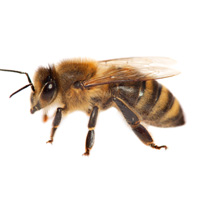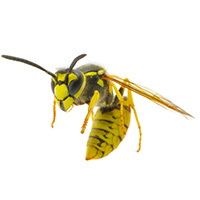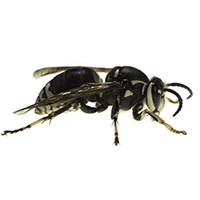
It’s that time of the summer when you’re likely to see more hornets and wasps flying around your property, or even worse, building nests. But with their striped bodies, dark and light markings and hovering flight, how do you tell the difference between wasps, hornets and bees? Here are some easy ways you can differentiate between these three types of stinging insects.
We’ll start with bees because they’re the insect that most people think they’re dealing with when they call us.
The species of bees that you’re most likely to encounter in southern Ontario is the bumblebee or the honey bee.
The telltale sign of a bee is that they have fuzzy bodies. Their yellow and black fur is vital to their survival, but because of that fur there isn’t a sharp distinction between their colours.

Bees are also not very aggressive. As long as you don’t pose a threat to them, they’ll likely be happy enough to buzz around looking for water, food or nectar.
Wasps are probably the most common type of insect that you’ll find outside, and because of their colours they’re frequently mistaken for bees. Like bees, wasps have yellow and black bodies, but unlike bees they do not have fur and there is a sharp contrast between the colours on their bodies.

Yellow jackets and paper wasps are the most common type of wasps you’ll find in southern Ontario.
Wasps are attracted to sweet smells and bright colours, so if you’re outside and have food out in the open, especially pop, you’ll likely be paid a visit by some wasps.
Unlike bees, wasps can be quite aggressive and can sting multiple times. Wasps are also social insects, so you’ll typically find them in swarms of just a few to hundreds near their nest.
The third of the three types of stinging insects that you might encounter are hornets.
Hornets look less like bees than wasps do, so they’re not mistaken for bees as often. Hornets do not have fuzz on their bodies and do have a sharper distinction between the colours on their bodies, but unlike wasps, the stripes on their bodies are a much lighter, in some cases almost white. Hornets are also generally larger than wasps, longer than 1” in their bodies as compared to ½” to 1” in body length for wasps.

Hornets are more likely to build their nests in trees and shrubs so are more often found in wooded areas. Like wasps, they can be quite aggressive with little provocation and can sting their pretty multiple times.
Dealing with wasps, hornets or bees isn’t fun, especially if they’re around your backyard and could potentially bother or sting family and friends. With their yellow and black colours, bees and wasps are the most common stinging insects you’ll find. Hornets look similar, but have lighter colours in their bodies. Bees usually aren’t aggressive unless threatened, but hornets and wasps can sting with little provocation.
If you’re dealing with wasps, hornets or bees, trust the experts at Pest Protection Plus! Our hornet and wasp removal services are fast, affordable and fully guaranteed. Contact us now for a no-obligation quote!
And always remember …
Hi,
Thanks for the comment, always reach out for professional medical assistance as allergic reactions can happen. This is a guide that can be followed too:
1. Stay Calm and Move Away
First, ensure you and the stung person are away from the area to avoid more stings, as wasps can be aggressive and may sting multiple times.
2. Remove the Stinger (If Present)
Unlike bees, wasps usually don’t leave their stinger in the skin, but if you see one, gently scrape it out with the edge of a credit card or your fingernail. Avoid using tweezers or squeezing it, as this can release more venom.
3. Clean the Area
Wash the sting site with soap and water to remove venom from the surface of the skin, which can help reduce the severity of the reaction.
4. Apply Cold
Use a cold pack or a cloth-wrapped ice pack and apply it to the sting site for about 10 minutes. This helps reduce swelling and pain. Avoid applying ice directly to the skin to prevent frostbite.
5. Pain Relief
Over-the-counter pain relievers such as ibuprofen or acetaminophen can be used to manage pain. Follow the dosage instructions on the label.
6. Reduce Swelling and Itching
Antihistamines can be taken to reduce itching, swelling, and hives. Be sure to follow the dosage on the package and be aware of potential drowsiness.
Hydrocortisone cream or calamine lotion applied to the sting site can also help relieve itching and swelling.
7. Monitor for Allergic Reactions
Most importantly, watch for signs of a severe allergic reaction (anaphylaxis), which can include difficulty breathing, swelling of the face or mouth, rapid pulse, severe hives, dizziness, or a drop in blood pressure. If any of these symptoms occur, call emergency services immediately.
8. Home Remedies
Some people find relief with home remedies, such as:
Applying a paste made from baking soda and water to neutralize the sting’s acidity.
Using vinegar or apple cider vinegar on a cotton ball to dab the sting site, which can help neutralize wasp venom.
9. Avoidance
After treatment, try to avoid the area where the sting occurred or any known wasp nests. Wear protective clothing if you must be in areas where wasp presence is high.
10. Hydration and Rest
Ensure the person who got stung stays well-hydrated and rests as their body recovers from the sting.
We have lots of wasps in the play area of our school what first aid do you do for wasp bs bee sting?